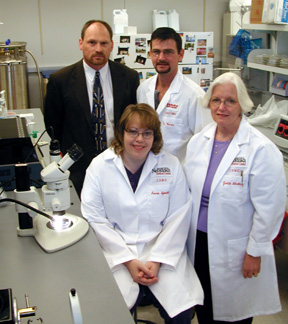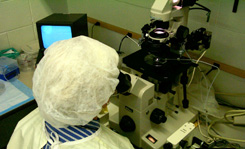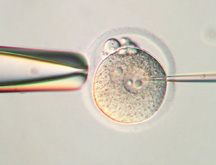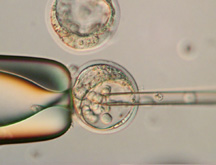 |
The staff of the MGE core facility, from left, Dr. J. Michael Salbaum, Laura Spaulding, Don Harms, and Judith Stribley. |
Brilliant minds and specialized experts from around the world become a part of UNMC to uncover the hidden secrets of diseases. Research to find a cure often starts with cell cultures in a dish. However, such cultures can’t always tell the whole story. After all, therapeutic success requires that the patient, i.e. the organism as a whole entity, gets well. This is where modern biomedical research turns to the laboratory mouse for help.
Mice are used in biomedical research because man and mice are quite similar in respect to their genomes, genes, and DNA sequences. It is because of these similarities that the laboratory mouse can be used to generate model systems for human diseases. These mouse model systems can then be studied in exquisite detail, reveal insights into molecular, cellular, physiological, and behavioral aspects of the disease, and serve as the first proving ground for new drugs or therapies.
 |
Judith Stribley in the process of generating transgenic mice. She performs DNA microinjections into mouse embryos under a high powered microscope. |
The process of adding or subtracting genes in the mouse genome requires dedicated technology and highly specialized expertise. Here at UNMC, the Mouse Genome Engineering Facility (MGE) of the Center for Human Molecular Genetics (CHMG) within the Munroe-Meyer Institute provides this technology and expertise to investigators on campus who need specific mouse models for research.
What Is the Mouse Genome Engineering Facility?
 |
Pronuclear microinjection with DNA to produce a ‘transgenic’ mouse. |
The MGE facility is under the direction of J. Michael Salbaum, Ph.D. (CHMG/MMI). He reports to UNMC’s vice chancellor for research on MGE activities.
 |
Generation of ‘gene knockout’ mice. |
MGE services are used by investigators in a variety of UNMC laboratories including UNMC’s Eppley Institute for Research in Cancer and Allied Diseases, the Center for Neurovirology and Neurodegenerative Disorders, and MMI’s Center for Human Molecular Genetics.